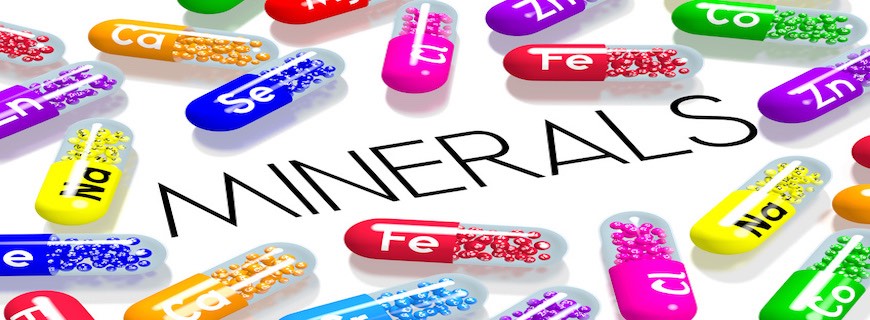Only by eating a broad range of vitamin- and mineral-rich foods – and minimising our intake of artificial sugars and trans fats – will we ever attain optimum health.
In this blog, we intend to summarise the primary function of minerals in the human body.
Minerals contribute to a range of important physiological processes, and deficiency can lay the groundwork for a host of serious illnesses.
What are Minerals?
Minerals are essential nutrients which act as catalysts to allow vitamins and enzymes to perform their necessary functions in the body.
Crucial to all of life’s functions, minerals aid our metabolism, permit water balance and contribute to our bone density. They also play a part in keeping our heart, brain and circulatory system in good working order.
But where do these inorganic substances come from, you might reasonably wonder. Minerals are sourced from soil and strata, meaning we get them from veggies, fruit, grains and meat.
We also get them from water – hence mineral water.
Minerals represent roughly 4% of your body’s mass, and since they cannot be naturally manufactured in the manner of, say, vitamin D, we must rely on our diet to meet daily needs.
As with many vital nutrients, however, deficiencies are not uncommon. In particular, people who follow a typical western diet may be deficient in iron, iodine, calcium and magnesium, in addition to vitamins like A, D and B12.
Examples of Minerals
Not only do experts disagree about how many minerals are ‘essential’, but they also debate how many minerals – essential or otherwise – exist!
In the interests of keeping things uncontroversial, let’s just say there are around 3,800 currently known.
Some are relevant purely to geologists, though. As far as dietary minerals are concerned, it’s safe to say that the figure is far smaller.
Most people are familiar with the primary macrominerals – the kind required by the body in significant quantities since they have important physiological duties.
The seven major macrominerals are calcium, magnesium, sodium, phosphorus, potassium, chloride and sulphur, and we need more than 100mg of each every day.
Trace minerals shouldn’t be overlooked, of course. We might need less of them (sub 100mg per day) but they remain key components of a good diet. Think about role of iron in carrying oxygen in red blood cells, for example, or of iodine in making thyroid hormones.
Other examples of micro or trace minerals include manganese, zinc, copper, cobalt, chromium, fluoride and selenium.
Sources of Minerals
If you eat a balanced diet comprised of 10 portions of vegetables and fruit per day, plus lean protein sources, you should get all the minerals you need.
Sadly, very few people manage this. Indeed, the chair of the Royal College of GPs, Dr Helen Stokes-Lampard, thinks two-a-day would be a more realistic target for some people.
And the situation isn’t much better in the States. Last year, the Centers for Disease Control and Prevention found that, on average, Americans eat fruit once per day and vegetables 1.7 times per day.
To avoid common nutritional deficiencies, be sure to eat a good selection of the foods listed below.
Functions and Sources of Calcium
Calcium is principally known for building strong bones and teeth. However it has many more roles besides. No surprise given it’s the most abundant mineral in the human body.
As well as contributing to healthy blood clotting and energy-yielding metabolism, not to mention proper muscle function (regulating heartbeat) and neurotransmission, calcium facilitates the function of digestive enzymes.
A serious calcium deficiency can lead to osteoporosis, a condition typified by brittle bones.
Great dietary sources of calcium include:
• Leafy green vegetables like broccoli, spinach, kale
• Almonds, hazelnuts
• Mackerel, salmon and sardines – also great sources of omega-3!
• Dairy foods like cheese, milk, butter and yogurt
• Pulses and sesame seeds
• Tofu
In the UK, the Recommended Daily Intake for calcium is 700mg, and as noted by the Department of Health, “taking 1,500mg or less a day is unlikely to cause any harm.”
Functions and Sources of Magnesium
We have written often about magnesium because – like many nutritionists and medical doctors – we passionately believe that it is vital to our wellbeing.
How could it not be? Our muscles contain approximately 27% magnesium, and our bones 60%. The macromineral is involved in over 300 biochemical reactions, helps with electrolyte balance and protein synthesis, psychological function and the nervous system.
Like calcium, it also plays a major role in keeping our bones and teeth strong, although it’s instrumental, too, in cardiovascular health. Its chief mechanism in this regard is to regulate sodium and potassium levels and thereby maintain healthy blood pressure.
In a 2016 meta-analysis of 40 cohort studies totalling over 1 million participants, an increase in magnesium intake was associated with a 22% reduction in the risk of heart failure and a 7% reduction in stroke risk.
In a separate study from last year, the risk of developing type 2 diabetes was revealed to be 4% lower with each additional 50mg a day of magnesium. People with the greatest magnesium intake enjoyed a 15% lower risk of developing T2D than individuals with the lowest intake.
Because magnesium is involved in so many biochemical reactions, magnesium deficiency can manifest itself in a number of ways. The most common symptoms are fatigue, muscle crap and insomnia.
Great dietary sources of magnesium include:
• Leafy green vegetables
• Nuts
• Fish
• Brown rice
• Bananas
• Meat
• Dairy foods
The UK Recommended Daily Intake for magnesium is 300mg for adult males and 270mg for adult women.
If have need for a magnesium supplement, try Multimagnesio. Available in tablet form, each serving provides 400mg total magnesium, from a combination of different salts to aid absorption.
Functions and Sources of Potassium
Potassium is synonymous with bananas, but unlike calcium or magnesium it has not received much mainstream attention.
This macromineral is known for helping to control the body’s fluid balance and also for being a vasodilator – i.e. helping to open blood vessels and thereby reduce blood pressure.
It is probably one of the most underrated nutrients for our heart.
Since it is present in several foods, true potassium deficiency (hypokalemia) is quite rare. It can, however, occur when your body loses a lot of fluid through excessive sweating, sickness or blood loss.
Yes, bananas are an excellent dietary source of potassium but so too are:
• Vegetables like broccoli, beet greens and Brussels sprouts
• Nuts, seeds and pulses
• Beef
• Chicken
• Fish
• Pulses
• Baked yams
In the UK, the RDA for potassium is 3,500mg for all adults.
Functions and Sources of Iron
Just as potassium is synonymous with bananas, iron is synonymous with meat: understandable since the body can absorb up to 40% of iron from meat but only 20% from vegetables.
The presence of iron is critical to the production of red blood cells. Around 70% of the iron in your body is actually located in the red blood cells of your hemoglobin, and in muscle cells called myoglobin. Each is essential for oxygen transfer.
The rest of your body’s iron is stored in the liver, spleen, muscles and bone marrow. In addition to its blood-building capacity, iron contributes to cognitive function, immunity, muscle activity and energy levels.
As with potassium, iron deficiency is mostly caused by blood loss. Consequently, women who lose lots of blood during their monthly menstrual cycles are at higher risk of iron deficiency anaemia and may need to use iron supplements.
In fact, women have a greater need for iron year-round.
Both folic acid and vitamin C help your body to better absorb iron, and eating meat or fish – in conjunction with other foods containing iron – also enhances absorption.
Quality sources of iron-rich food include:
• Meat (beef, pork, lamb, chicken, turkey, liver)
• Fish, including shellfish
• Vegetables (broccoli, kale, bean sprouts, lima beans)
• Nuts
• Eggs
• Dried fruit
• Soybean flour
The UK RDA for iron, meanwhile, is 8.7mg for men over 18; 14.8mg for women aged 19-50; and 8.7mg for women over 50.
An iron supplement may be necessary for some people to meet their intake. During periods of growth in infancy, childhood and adolescence, for example, iron requirements can outstrip dietary supply. It is thought that a quarter of British women fail to get enough dietary iron.
Because it is quickly absorbed, bypassing the digestive system entirely, sublingual iron is preferable to iron tablets or capsules.
Functions and Sources of Zinc
Although it’s a trace element, zinc is hugely important – for our immune system, for our cognitive faculties, for our fertility; for our skin, bones, hair and nails.
In fact, zinc helps stimulate the activity of at least 100 enzymes. It is known for being a potent anti-inflammatory, and a deficiency can set the stage for chronic disease.
According to a 2017 study published in the American Journal of Clinical Nutrition, even a modest daily increase in zinc can “reduce DNA damage and alter the concentrations of serum proteins involved in DNA repair, oxidative stress and inflammation.”
Men with prostate and infertility problems are often found to be lacking in zinc and may need to rely on supplements.
The same applies to those battling eating disorders, alcoholism or digestive problems, as well as people following a plant-based diet.
On the whole, though, zinc deficiency is not too common. If it does rear its head, the symptoms tend to be changes in appetite, weight gain, digestive trouble and poor immunity.
Dietary sources of zinc include:
• Meat
• Shellfish (especially oysters)
• Eggs
• Lentils
• Wholegrain bread
• Nuts
• Fortified dairy products
It is often advised that zinc be paired with other antioxidants such as vitamin C to potentiate its effects.
The UK RDA for zinc is 9.5mg for adult men and 7mg for women.
Eat a Varied Diet to Avoid Mineral Deficiency
There are, of course, many more minerals you should be aware of. The important thing is to eat a diversity of natural foods to avoid deficiency.
Food is always the best source of minerals (and vitamins for that matter), but soil depletion means it can be difficult to meet our requirements in some cases.
Unfortunately, crops grown decades ago were far richer in vitamins and minerals than what we enjoy today.
Modern intensive agricultural practices are to blame, with one study from 2004 finding “reliable declines” in the amount of protein, calcium, phosphorus, iron, riboflavin (vitamin B2) and vitamin C in 43 fruit and vegetables.
The study compared the nutrient content of fruit and vegetables from 1950 to those from 1999.
Conclusion
If you want to get the most nutritious fruits and vegetables, make a point of buying from local organic farmers or selecting organic at the supermarket. Foregoing pesticides and fertilisers is undoubtedly good for the soil.
If you feel you could benefit from any form of mineral supplementation, don’t hesitate to get in touch with us; we are happy to talk through your requirements and make suggestions.
Meantime, make sure you’re eating plenty of natural mineral-rich foods!
Water for Health Ltd began trading in 2007 with the goal of positively affecting the lives of many. We still retain that mission because we believe that proper hydration and nutrition can make a massive difference to people’s health and quality of life. Click here to find out more.




























Leave a comment